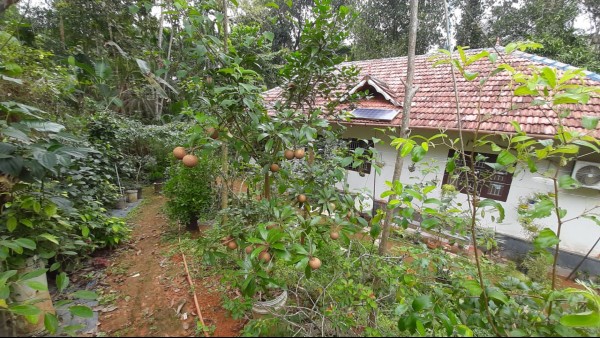Basheer Kalakkal, who was born and raised in Kozhikode district, Kerala, did not have any architectural background or experience needed to build a house. “I’m just a Class X pass out,” he says, and adds, “It was my love for the environment that took me down this path. I cultivate fruits and vegetables, and I’m an environmentalist.”
While protesting sand mining and brick carving, the 61-year-old is often asked if and how he will build a house without the two practices. “Today, not only have I built a mud house, I now also help others make similar ones,” Basheer tells The Better India.
In 2016, Basheer constructed the mud house, which is surrounded by mango and guava trees. “All the mud we used for constructing our home was taken from our land itself. As the land was on a slant, we had to level it using an earth mover. So, the excess mud was collected and used for our property,” he says.
Basheer follows Zero Budget Natural Farming (ZBNF), which helps plants grow naturally without the use of pesticides or fertilizers. He takes up contracts from people who wish to have this system in their homes or on their lands. Due to his work, he, along with his family, often have to travel across the state. Up until 2016, they preferred rented rooms, but as the family expanded, Basheer realised he needed a house of his own.
“Mud houses do not harm the environment, and I’d been wanting to build one for a very long time,” he says, adding, “I found that my area had very few mud houses as well. I chalked out a plan in my head, in terms of how much mud I would need, and the number of workers I would need.”
But Basheer faced many sceptics, who told him that a mud house would not be as spacious as modern-day houses. However, he helped them understand how a house can be built in a way that is low-budget and incorporates modern needs. The mud house is built within 1,090 sq ft, and includes three bedrooms with attached bathrooms, a kitchen, a work area, a hall, and an outdoor seating area. He has used normal tiles for the floors, while roofing has been done with fired-clay tiles. The sextagenarian claims these mud houses can be built within three months. “Our house was built in one year. The construction took more time, as I was busy travelling. Otherwise, the work can be completed within three months,” he says.
The process

Basheer says a proper proportion of mud and water is required as per the size of the house. He adds that the house does not use mud thicker than two inches.
“We did not purify the mud using a net or other machinery, and used our hands to remove the thicker mud. After the powder soil was sorted, it was mixed with cow urine, fenugreek, haritaki powder, persea macrantha, and water. After this, we took the mixture, which was now solid, to set up the house. In case the mixture becomes too liquidy due to excess water, we add more mud to get the correct proportion,” he says.
Four farmers helped Basheer build the house. “I met them while carrying out ZBNF. They told me they had made mud houses before, and I immediately asked them if they could help me build mine,” he says, adding, “I paid the helpers Rs 15,000 in total, and the full cost of the house was Rs 9 lakh. If one were to build the house within a lesser area, the cost would’ve been reduced.”
The only part of the house that uses cement is the tiles, which was due to the insistence of Basheer’s wife. Talking about the mud house’s merits, he says it’s malleable, disaster-resistant, recyclable, has thermal insulation, and costs less to maintain.
Basheer says many have reached out to him to learn the technique of making mud houses.
‘An eco-friendly life can be easy’
Basheer also has a garden which includes fruits and vegetables. All plants are cultivated using ZBNF. “At home, I cultivate tomato, brinjal, chilli, cabbage, cauliflowers, pepper, guava, bananas, coconut, and miracle fruit. Most of these are cultivated in grow bags,” he says.
He also owns land in Palakkad’s Attapadi, where he cultivates more varieties of mangoes, bananas and other fruits and vegetables.
Basheer says he wants others to understand that leading an eco-friendly lifestyle is not as difficult as one might think. “With small steps, we can coexist without harming Mother Earth. I’m willing to help others realise this in all ways possible,” he says.
(Edited by Divya Sethu)
If you found our stories insightful, informative, or even just enjoyable, we invite you to consider making a voluntary payment to support the work we do at The Better India. Your contribution helps us continue producing quality content that educates, inspires, and drives positive change.
Choose one of the payment options below for your contribution-
By paying for the stories you value, you directly contribute to sustaining our efforts focused on making a difference in the world. Together, let's ensure that impactful stories continue to be told and shared, enriching lives and communities alike.
Thank you for your support. Here are some frequently asked questions you might find helpful to know why you are contributing?

